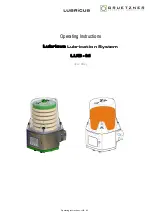
PAGE 3
The control valve, fitting and/or bypass are designed to
accommodate minor plumbing misalignments but are
not designed to support the weight of a system or the
plumbing.
Do not use Vaseline, oils, other hydrocarbon lubricants or
spray silicone anywhere. A silicone lubricant may be used
on black o-rings but is not necessary.
Avoid any type of
lubricants, including silicone, on the clear lip seals.
The nuts and caps are designed to be unscrewed or
tightened by hand or with the special plastic wrench
(V3193). If necessary, pliers can be used to unscrew the
nut or cap. Do not use a pipe wrench to tighten or loosen
nuts or caps. Do not place a screw driver in the slots on
caps and/or tap with a hammer.
Do not use pipe dope or other sealants on threads. Use
Teflon tape on the threaded inlet, outlet and drain fittings.
Teflon tape is not necessary on the nut connection or caps
because of o-rings seals.
After completing any valve maintenance involving the
drive assembly or the drive cap assembly and pistons,
unplug power source jack from the printed circuit board
(black wire) and plug back in or press and hold
NEXT
and
REGEN
buttons for 3 seconds. This resets the electronics
and establishes the service piston position. The display
should flash the software version and then reset the valve
to the service position.
Solder joints near the drain must be done prior to
connecting the drain line flow control fitting. Leave at least
6” between the drain line control fitting and solder joints
when soldering pipes that are connected on the drain
line control fitting. Failure to do this could cause interior
damage to the drain line flow control fitting.
When assembling the installation fitting package (inlet
and outlet), connect the fitting to the plumbing system first
and then attach the nut, split ring and o-ring. Heat from
soldering or solvent cements may damage the nut, split
ring or o-ring. Solder joints should be cool and solvent
cements should be set before installing the nut, split ring
and o-ring. Avoid getting primer and solvent cement on
any part of the o-ring, split rings, bypass valve or control
valve.
Install grounding strap on metal pipes.
This water filter is not to be used for treating water
that is microbiologically unsafe or of unknown
quality without adequate disinfection before or after
treatment.
GENERAL INSTALLATION
AND SERVICE WARNINGS
PRE-INSTALLATION
REVIEW
WATER PRESSURE:
A minimum of 20 pounds of water
pressure (psi) is required for backwash. Maximum 100
psi. CAUTION: the filter cannot be subject to a vacuum
due to loss of pressure (such as a water main break or
submersible well pump check valve failure).
WATER TEMPERATURE:
The range of water temperature
is 35°F to 100°F. DO NOT install any water filter with less
than 10 feet of piping between its outlet and the inlet of a
water heater.
AMBIENT TEMPERATURE:
DO NOT locate filter where it
or its connections (including the drain and overflow lines)
will ever be subject to room temperatures under 33°F.
ELECTRICITY:
An uninterrupted 120 volt 60Hz source is
required.
Make sure electrical source is not on a timer
or switch.
All electrical connections must be connected
according to local codes. The plug-in transformer is for
dry locations only. Surge protection is recommended with
all electrical connections.
DRAIN:
All plumbing should be done in accordance with
local plumbing codes. The distance between the drain
and the water filter should be as short as possible. The
pipe size for the drain line should be a minimum of 1/2”
(inside diameter of pipe). For backwash rates of 7 gpm or
higher, use a 3/4” drain line.
FILTERING:
It is recommended that the filter be installed
to treat both the hot and cold water supply. Outside faucets
should be left on untreated water.
BYPASS:
A bypass valve (optional accessory) should
be installed so that water will be available if it should be
necessary to shut off the pressure in order to service the
filter.




































